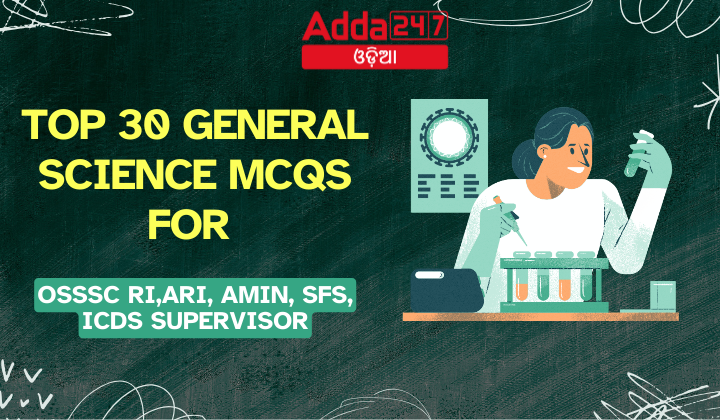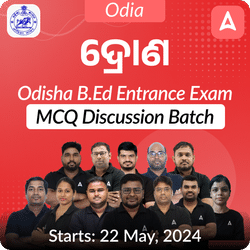General Studies is a crucial component of various competitive exams like OSSSC RI, ARI, Amin, SFS, and ICDS Supervisor. It encompasses a wide range of topics, from current affairs to history, geography, polity, and more. To excel in these exams, it’s essential to have a strong grasp of general knowledge. Here, we present a curated list of the top 30 Multiple Choice Questions (MCQs) that are commonly encountered in these exams, covering diverse subjects to help you prepare effectively.
Top 30 General Studies MCQs For OSSSC RI,ARI, Amin, SFS, ICDS Supervisor
- Those reactions in which two or more substances combine to form a single substance is called:
A. Combination reaction
B. Displacement reaction
C. Decomposition reaction
D. Double displacement reaction
Ans. A - Those chemical substances which have a sour taste are:
A. Salt
B. Acid
C. Bases
D. None of the above
Ans. B - Those chemical substances which have a bitter taste are:
A. Acid
B. Bases
C. Salt
D. Concentrated Acids
Ans. B - The scale on which the strength of acid solutions as well as basic solutions could be represented by making use of hydrogen ion concentrations in them is called:
A. Balance scale
B. Platform scale
C. Pan scale
D. pH scale
Ans. D - A compound formed from an acid by the replacement of the hydrogen in the acid by a metal is called:
A. Base
B. Salt
C. Concentrated Acid
D. Alkali
Ans. B - What is the chemical bond formed by the transfer of electrons from one atom to another is called?
A. Single covalent bond
B. Ionic bond
C. Double covalent bond
D. Triple covalent bond
Ans. B - The chemical bond formed by the sharing of electrons between two atoms is known as:
A. Ionic bond
B. Triple covalent bond
C. Covalent bond
D. Single covalent bond
Ans. C - What is a homogeneous mixture of two or more metals called?
A. Salt
B. Alloy
C. Alkali
D. Acid
Ans. B - What is an unsaturated hydrocarbon in which the two carbon atoms are connected by a double bond called?
A. Alkanes
B. Alkenes
C. Alkynes
D. Ionic bond
Ans. B - An unsaturated hydrocarbon in which two carbon atoms are connected by a triple bond is called:
A. Alkynes
B. Haloalkanes
C. Alkenes
D. Ketones
Ans. A - In the case of a concave mirror, the image of an object is:
(a) Real, erect, and diminished when the object lies beyond the centre of curvature.
(b) Real, inverted, and of the same size as the object when it lies between the centre of curvature and focus.
(c) Real, inverted, and diminished when the object lies beyond the centre of curvature.
(d) Not real, large, and unproportional.
Ans. (c) - To increase the magnifying power of a telescope, the focal length of:
(a) Objective lens should be increased.
(b) Objective lens should be decreased.
(c) Eye-piece lens should be increased.
(d) Eye-piece lens should be decreased.
Ans. (d) - Why does the colour of the ocean appear blue?
(a) Because the sunlight falling on it is reflected.
(b) Because the sunlight falling on it is refracted.
(c) Because the sunlight falling on it is absorbed.
(d) Because the sunlight falling on it is scattered.
Ans. (d) - What is the power of a concave lens?
(a) Positive
(b) Negative
(c) Both
(d) None of the above
Ans. (b) - Which glasses or lenses are used to correct the short-sighted eye defect?
(a) Concave Lens
(b) Convex Lens
(c) Bipolar Lens
(d) None of the above
Ans. (a) - In projectors, which lenses are used?
(a) Convex lens
(b) Concave lens
(c) Bipolar lens
(d) Both (a) and (b)
Ans. (a) - Due to which phenomenon does a stick immersed in water appear to be bent?
(a) Reflection
(b) Dispersion
(c) Refraction
(d) Scattering
Ans. (c) - Due to which phenomenon do light rays emerging from a cinema machine spread wide on the screen?
(a) Dispersion
(b) Diffraction
(c) Scattering
(d) Refraction
Ans. (b) - A dental mirror is what type of mirror?
(a) Convex mirror
(b) Concave mirror
(c) Plane mirror
(d) Both (b) and (c)
Ans. (d) - What type of mirror is used in anti-shoplifting devices?
(a) Concave mirror
(b) Convex mirror
(c) Plane mirror
(d) None of the above
Ans. (b) - An ancient book of 1000 B.C. that deals with health, hygiene, longevity, etc. is?
A. Sushruta Samhita
B. Atatharvaveda
C. Bhela Samhita
D. Charaka Samhita
Ans: B - Name a concise and scientific exposition of Ayurveda in verse form, distinguished by its knowledge of chemical reactions and laboratory processes.
A. Vrdukunta
B. Vaghata
C. Kasyapa Samhita
D. None of the above
Ans: B - Name an ancient book that describes difficult surgical operations like opening of the brain.
A. Celsus
B. Bhela Samhita
C. Chivaravastu
D. Agnivesa Samhita
Ans: C - Which ancient book of 600 B.C. deals with pediatrics?
A. Kasyapa Samhita
B. Agnivesa Samhita
C. Bhela Samhita
D. None of the above
Ans: A - A treatise on the rasa chikitsa system of ancient medicine, which considers mercury as the king of all medicines is?
A. Vaghata
B. Tristia
C. Gandavadha
D. Vrdukunta
Ans: D - A treatise on medicine and surgery from Alexandria and Rome is?
A. Celsus
B. Hippocratic Oath
C. Georgics
D. Aeneid
Ans: A - Which of the following ancient books is the codification of medicine scattered in the Vedas?
A. Bhela Samhita
B. Charaka Samhita
C. Sushruta Samhita
D. None of the above
Ans: A - Who is considered the father of Western medicine?
A. Hesiod
B. Hippocrates
C. Both 1 and 2
D. Neither 1 nor 2
Ans: B - Name the first book on medicine in China.
A. Huangdi Neiching
B. Celsus
C. Vaghata
D. None of the above
Ans: A - A classical exposition of Indian medicine that deals with almost all branches of medicine is?
A. Madhavacharaya
B. Kasyapa Samhita
C. Charaka Samhita
D. Agnivesa Samhita
Ans: C










